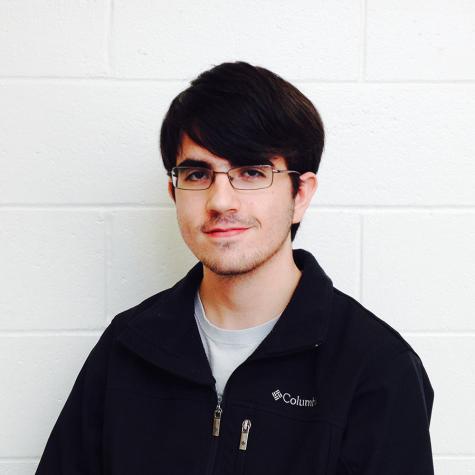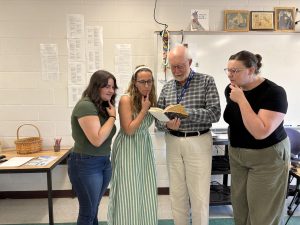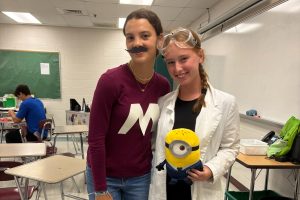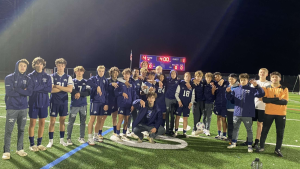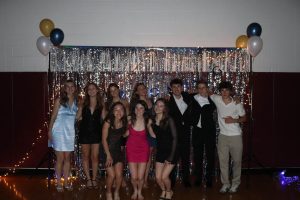Robotics Removed
Part two of the series on NEASC accreditation at HBHS
The new classroom, which used to be the location of First Robotics Team 1073. Photo Credit: Evan Moloney
September 21, 2014
While Administration’s push toward accreditation has prompted a number of significant changes within the school, one of the most striking has been that regarding Room 374, formerly known to the school as the Tech Shop.
The room has been cleared and its contents moved to the middle school, with new tables and equipment installed to create a new science laboratory. The change serves to satisfy a bigger mandate, one regarding HBHS and its NEASC accreditation, which may be taken away due to a lack of space and many other school-wide issues.
However, as this change has been made along with many others across the school, the Robotics team has suffered collateral damage.
Room 374 was formerly most utilized as Team 1073’s work-space, a hub of activity and a constant supply of resources with which the group designed, created, and tested its robots.
The team, based in this shop and the school’s adjacent Tech Center, used the room to house hundreds of tools, parts and students for Robotics meetings. However, the general consensus among the team and its leaders is that the tech shop’s removal has become more inconvenient than sentimental.
“Change brings along challenge,” said Sue Hay, the Robotics team’s faculty adviser, “but as engineers, it’s our job to embrace those challenges and keep moving on.”
Alex Baryiames ‘15, Vice President of the team’s Electrical sub-group, agreed with the sentiment, “I’m really grateful that we have somewhere to go, and that SAU-41 is kind of looking out for us. This isn’t them trying to get rid of us, it’s us just having to work with them.”
Richard Barnes, HBHS Principal, spoke to the same themes: “We were faced with the choice of doing nothing, or having them move so we could occupy a big space.”
This means that the room change was nothing personal–the addition of a new science lab created, inBarnes’ words, a “domino effect” which opened up more space as rooms around the school were shifted.
Barnes did acknowledge that it was better for the high school to host the team–the biggest problem for 1073 is that resources are now not as readily available in their new location. During meetings at the middle school, sub-groups must spread out all over the building; groups in need of computers migrate toward the eighth-grade wing, engulfing another part of the school in activity..
And while, in the off-season, this is not as large a problem, during the annual Build Season the team will be forced to adapt and find a different way to thrive in their new environment.
While based at the high school, the push to build the robot was a coordinated effort which could be worked on from all fronts. During CavBlock and PLC, free periods, and after school until perhaps one to two o’clock the next morning, students were able to devote their time toward the project. At the middle school, however, access is not nearly as simple. Given that people are learning in the classrooms utilized by the Robotics team, activities during school hours are all but impossible–and hours during the night will experience a blow as well.
“At the high school, there was a kind of understanding with the janitors,” said Baryiames. “They were okay with us staying there till who-knows-what-time because it was something that meant a lot to us and only happened once a year.”
However, given that the faculty and staff at HBMS do not have experience with the team, Baryiames and others expect some distrust toward it. Being asked to leave so that the janitorial crew can do its work could cut down on time available to work on the robot, and affect the team’s performance at competitions.
Meanwhile, Room 374 has been converted into an additional science classroom in order to satisfy NEASC demands, which stated that Hay’s room was ill-equipped to teach the subject. It has been outfitted with lab tables and given an overhaul thus far, with more changes on the way.
Catherine Orzech received the room, moving from a teaching cart to a desk. She said she hasn’t experienced negative push-back from the Robotics team, or any push-back at all.
“The Robotics kids have been really great and accommodating,”Orzech said. “And at the same time, this room holds a lot of science potential which I think will be good for students.”
Plans for the room include creating lab benches, workstations, and putting in full equipment, very similar to the classrooms across the hall.
But according to Hay, the room was never designed to service a science class. It was specifically designed as a shop, outfitted with extra floor space, an extra-wide door and electrical resources far greater than in most of the school.
However, this alternative is preferable compared to some of what the SAU may have had to do otherwise.
“There were discussions about moving freshmen down to the middle school,” said Barnes.
HBMS has a problem opposite that of the high school–there is too much space, rather than too little. However, after much deliberation the decision held that creating a crowding problem in two schools, which would have been the inevitable result, was less favorable than confining it to one.
Given that other options have been done away with, recreating Room 374 will take a large budget and plenty of time, but according to Orzech, the cost is nothing short of favorable. “When you weigh what we have to spend on this room to get it ready for work, versus what we would have paid for the addition the town was considering in the spring, this is absolutely a better option.”
But according to Baryiames, the room is worth a bit more than its scientific potential. In terms of earning renewal for the school’s NEASC accreditation, he agrees that the effort is warranted, but at the same time there is a greater cost.
“In terms of the community, and the opportunities that people have had at this school, we lost something really important.”
Barnes echoed Baryiames’s statement. “In the short term, this is worth it, but if we don’t get a long-term solution, this isn’t going to help.”




